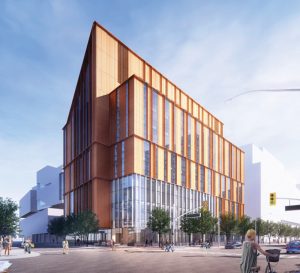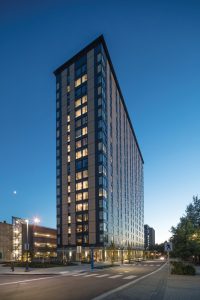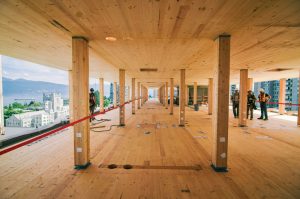For centuries, structural engineers have been intrigued by the unique allure of designing buildings that rise higher, span longer, and assemble materials in new and counterintuitive ways. One of the current frontiers is building taller with wood. The introduction of cross-laminated timber has accelerated this pursuit, most notably in Europe and North America. While pushing the envelope is a noble objective, doing so just to secure bragging rights misses the mark. Just as the structural engineering community asks if it makes sense to build ever taller with concrete and steel, the same question can apply to tall wood towers.
Having been involved in the design of several tall timber buildings, including the 18 story TallWood House student residence at the University of British Columbia (at the time of completion, the tallest wood high rise in the world), the author offers some thoughts toward answering this question, beginning with some of the challenges in building tall with wood.

The taller the building, the more heavy-lifting that has to be performed by the columns and shear walls. With timber falling well shy of steel and concrete in the strength category, this results in larger columns and shear walls and decreased useable floor area in a tall wood building. In addition, if wood columns are exposed, charring requirements for fire protection will exacerbate this differential.
Tall timber buildings typically weigh less than their concrete and steel cousins; however, these advantages begin to diminish when breaking through the 30 to 40 story barrier, where controlling wind accelerations can benefit from the increased mass.
Using CLT shear walls in buildings taller than 10 to12 stories, especially in severe seismic regions, can quickly become a futile exercise as steel connections between wall panel lifts become unduly large, long, and labor-intensive. This begs the question, “Why not use continuous steel columns or zone steel in concrete instead to manage overturning moments?”

If we allow ourselves to be nudged toward a hybrid solution with a steel or concrete core for lateral resistance in taller buildings, then the problem of differential vertical settlement between the concrete or steel core and wood columns arises. The author’s team found this a manageable problem on the 18-story TallWood House, compensating for future differential elastic, shrinkage, and creep deformation by ‘cambering’ the floors slightly between cores in the upper stories. The building is being monitored to understand long-term behavior better. However, as structural engineers break through the 25 to 30 story barrier, rigorous analysis and fine-tuning becomes a more pronounced challenge. Introducing further hybridization by substituting steel columns for wood columns neatly circumvents the differential deformation problem and still preserves the large volume of wood in the building. Another alternative that the author’s firm investigated for a 450-foot tower was to essentially stack three identically-framed TallWood House blocks on each other. A steel-perimeter truss transfer structure was then introduced at the one-third and two-thirds building height levels supported by four steel corner columns, effectively allowing us to skate around the vertical deformation problem.
Prolonged exposure to rain can pose additional challenges when building taller with timber in wetter climatic regions. While CLT is dimensionally quite stable under wet weather conditions, protecting fit-out work that wants to progress at lower levels of the building against moisture ingress requires additional rain protection management. As a minimum, the structure should be constructed and wrapped with the building envelope as quickly as possible.

However, notwithstanding these challenges, many factors speak in favor of building taller with mass timber. Allowing for material fabrication lead times, erection schedule savings can be one of the leading benefits. For example, it took only nine weeks to erect seventeen stories of mass timber construction at TallWood House. With a carefully detailed, efficient frame and a dedicated crane, mass timber structures can be erected at a pace of 10,000 square feet per day.
Mass timber construction can be erected in a quieter manner, which is increasingly desirable in urban environments, where neighboring building residents often must tolerate prolonged periods of excessive noise on tall building projects.
Wood is also a sustainable building choice when considering the renewability of the resource and metrics such as embodied carbon.
Current trends in office building construction relating to interior ambiance will also drive more tall buildings toward wood construction. The biophilic nature of building with wood has undoubtedly caught the attention of clients and users alike, not to mention the sustainability signal that a building constructed of material grown by the sun sends to the community at large. Time will tell how long this trend lasts.
The bottom line to all these considerations will, in the end, likely be largely influenced by cost. Interestingly, when tasked with designing the structure for TallWood House, the question was not “Can it be done?” (yes), or “Should we do it because it would be the tallest timber tower in the world?” (vain), but rather “Can we do it economically?”. This forced the team to determine, very near the outset of design, “Can we build a timber structure, with all its proposed sustainability advantages, for the same price as a more conventional steel or concrete building?” If the answer were no, the project would be constructed with concrete. Well, we ended up coming close enough to see the project built with timber. However, this answer is a function of many variables, including, most importantly, the cost of concrete and steel construction in a given region. Certainly, tall buildings in dense urban centers with high construction costs can lend themselves to timber construction, with off-site component prefabrication resulting in faster construction. In addition, office buildings with warmer ambiance and ample daylight also can be expected to secure higher rental income.
In light of these factors, does it make sense to build taller with wood? In the right location for the right building type, it absolutely does. And from a sustainability perspective, the most current research suggests we should keep moving forward.
However, let’s not force a square peg into a round hole. When your timber structure starts groaning, remember that other materials will gladly help out.■
